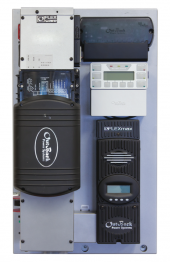Looking for Solar Help: 1) Pre-wired vs. AIO system, Manufacturer, etc., 2) then preparing an Electrical One-Line Diagram.
My situation:
Location, East Idaho, 6300ft elevation, just west of Yellowstone National Park. Purchased and moved the 612 ft2 cabin to my property in late 2018, saving it from being torn down to make way for a new hotel. Been restoring it ever since. Never want it to be a house, just a beautiful “glamping +” set up. I built and permitted an outhouse and installed a shallow sand point well which I pump with a 1926 era piston pump a friend and I rebuilt.
Access by road is limited to 6 months/year due to huge snow. -40F outside temps every couple of years, coldest recorded -60F. Electronics and battery will be located in uninsulated but full height basement.
An elevated, ground mounted solar panel array will be located 115ft south of the power panel in the basement to avoid ALL shade created by scattered lodgepole pines.
No power to property, completely off grid. Once I have solar power I can get internet.
I have to get my system design approved by the Idaho Department of Building Safety with components tested and approved to the UL-1741 standards, etc. This will include an Electrical One-Line Diagram – To verify compliance with the 2017 National Electrical Code (hand drawn OK).
https://dbs.idaho.gov/programs/elec...e-owners-installing-power-production-systems/
Though I have little electrical experience, I do have some competent friends and with the help of one, we wired my cabin last fall (120VAC) and passed my State Inspection the first time.
The plan:
48V System.
I have access to new 390W Canadian Solar BiHiKu Poly Perc, Bifacials locally ($205/each).
https://signaturesolar.com/content/documents/CANADIANSOLAR/CS3Wspec.pdf
I did an energy needs calc. 4 of the bifacials noted above will be more than ample for my current/future needs (1560 W).
I’m interested in an AIO or Pre-wired system for ease of installation and ease of passing my state inspection.
All in Ones (AIO) Systems:
EG4 6.5kW Off-Grid Inverter, $1,299
https://signaturesolar.com/eg4-6-5k-off-grid-inverter-6500ex-48/
Sol-Ark 5K, $4,500
https://www.sol-ark.com/wp-content/uploads/2021/10/5KSpecSheet_10-4-2021.pdf
Pre-wired Systems:
OutBack Power FLEXpower ONE FXR: VFXR3648A, 3.6kW, $4,100
https://www.outbackpower.com/downlo...expower_one_fxr/flexpoweronefxr_datasheet.pdf
Nominal Capacity: 100Ah
Kilowatt-hour(s): 5.12kWh
I will do what I need to do for an insulated and possibly heated battery box.
My goal with this post would be to 1) determine which AIO or Pre-wired system and battery(s) to purchase, and 2) once the system is selected, get help on the preparing the Electrical One-Line Diagram so I can submit to the State.
THANKS so much for your help and guidance.
PS, why doesn’t this forum have a section on pre-wired systems?
My situation:
Location, East Idaho, 6300ft elevation, just west of Yellowstone National Park. Purchased and moved the 612 ft2 cabin to my property in late 2018, saving it from being torn down to make way for a new hotel. Been restoring it ever since. Never want it to be a house, just a beautiful “glamping +” set up. I built and permitted an outhouse and installed a shallow sand point well which I pump with a 1926 era piston pump a friend and I rebuilt.
Access by road is limited to 6 months/year due to huge snow. -40F outside temps every couple of years, coldest recorded -60F. Electronics and battery will be located in uninsulated but full height basement.
An elevated, ground mounted solar panel array will be located 115ft south of the power panel in the basement to avoid ALL shade created by scattered lodgepole pines.
No power to property, completely off grid. Once I have solar power I can get internet.
I have to get my system design approved by the Idaho Department of Building Safety with components tested and approved to the UL-1741 standards, etc. This will include an Electrical One-Line Diagram – To verify compliance with the 2017 National Electrical Code (hand drawn OK).
https://dbs.idaho.gov/programs/elec...e-owners-installing-power-production-systems/
Though I have little electrical experience, I do have some competent friends and with the help of one, we wired my cabin last fall (120VAC) and passed my State Inspection the first time.
The plan:
48V System.
I have access to new 390W Canadian Solar BiHiKu Poly Perc, Bifacials locally ($205/each).
https://signaturesolar.com/content/documents/CANADIANSOLAR/CS3Wspec.pdf
I did an energy needs calc. 4 of the bifacials noted above will be more than ample for my current/future needs (1560 W).
I’m interested in an AIO or Pre-wired system for ease of installation and ease of passing my state inspection.
All in Ones (AIO) Systems:
EG4 6.5kW Off-Grid Inverter, $1,299
https://signaturesolar.com/eg4-6-5k-off-grid-inverter-6500ex-48/
Sol-Ark 5K, $4,500
https://www.sol-ark.com/wp-content/uploads/2021/10/5KSpecSheet_10-4-2021.pdf
Pre-wired Systems:
OutBack Power FLEXpower ONE FXR: VFXR3648A, 3.6kW, $4,100
https://www.outbackpower.com/downlo...expower_one_fxr/flexpoweronefxr_datasheet.pdf
- UL-1741 compliant
- cost
- reliability
- ease of operation (programming and understanding outputs)
- low idle power consumption
- low temp operation
- ability to communicate wirelessly
- availability.
Nominal Capacity: 100Ah
Kilowatt-hour(s): 5.12kWh
I will do what I need to do for an insulated and possibly heated battery box.
My goal with this post would be to 1) determine which AIO or Pre-wired system and battery(s) to purchase, and 2) once the system is selected, get help on the preparing the Electrical One-Line Diagram so I can submit to the State.
THANKS so much for your help and guidance.
PS, why doesn’t this forum have a section on pre-wired systems?







